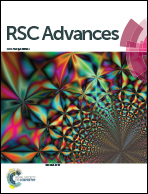Structure–property relationship of nitramino oxetane polymers: a computational study on the effect of pendant chains
Abstract
A comprehensive study of the effect of the structure of pendant chains on the energetic and mechanical properties of nitramino oxetane polymers has been conducted. Enthalpy of formation (EOF), density, glass transition temperature, and elastic moduli were calculated via quantum mechanics and molecular dynamic simulations. It is shown in this study that –CH2 groups are unfavorable for EOFs, densities, and elastic moduli of the polymers, whereas –NCH3NO2 groups are favorable for these parameters. The glass transition temperature (Tg) shows non-monotonic features with increasing –CH2 groups; it reaches a minimum value when the pendant chains consist of 1 or 2 –CH2 groups. Moreover, the location of the pendant chains can strongly affect Tg of the polymers. Our study suggests that the asymmetric structure, distantly located pendant chains and appropriate length of the pendant chains can effectively reduce Tg of the polymers with negligible compromise to other properties.



 Please wait while we load your content...
Please wait while we load your content...